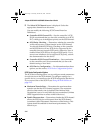
2-14
Adaptec SCSI RAID 2120S/2200S Software User’s Guide
5 The Select SCSI Channel menu is displayed. Select the
appropriate channel from this menu.
You can modify the following SCSI Channel Interface
Definitions:
■ Controller SCSI Channel ID — Sets the controller’s SCSI
ID. We recommend that you leave the controller set to SCSI
ID 7, which gives it the highest priority on the SCSI channel.
■ SCSI Parity Checking — Determines whether the controller
verifies the accuracy of data transfer on the SCSI channel.
You should disable SCSI Parity Checking on the controller
and all SCSI devices if any SCSI device supported by the
controller does not support SCSI parity; otherwise, leave it
enabled. Most SCSI devices do support SCSI parity. If you
are not sure whether a device supports SCSI parity, consult
the documentation for the device.
■ Controller SCSI Channel Termination — Sets termination
on the controller card. We recommend that you leave the
default setting of Auto Mode.
■ SCSI Device Configuration — For information about these
options, see the section, SCSI Device Configuration Options.
SCSI Device Configuration Options
The SCSI device settings allow you to configure certain parameters
for each device on the SCSI channel. To configure settings for a
specific device, you must know the SCSI ID assigned to that device.
If you are not sure of the SCSI ID, see Using the Disk Utilities on
page 2-15.
■ Maximum Transfer Rate — Determines the maximum data
transfer rate that the SCSI channel supports. The maximum
effective data transfer rate is doubled when Initiate Wide
Negotiation is set to Yes and 16-bit devices are attached. (Initiate
Wide Negotiation has no effect with 8-bit devices.)
■ Enable Disconnection — Determines whether the SCSI channel
allows the SCSI device to disconnect from the SCSI channel
(sometimes called Disconnect/Reconnect or Reselection). This
option should be enabled for maximum performance. The
default is yes.
UG.book Page 14 Saturday, October 26, 2002 12:08 PM


















